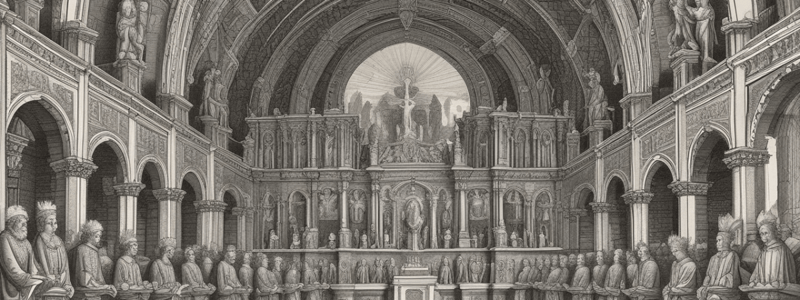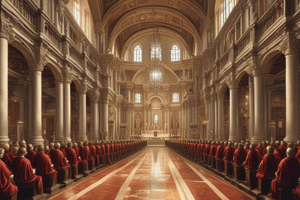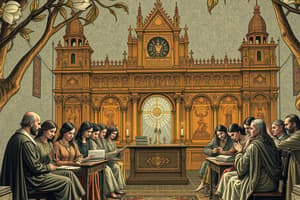Podcast
Questions and Answers
What was the complaint of the Council of Trent?
What was the complaint of the Council of Trent?
- The complexity of the catechisms
- The diversity of Christian denominations
- The simplicity of the catechisms
- The number of catechisms in Europe (correct)
Henry, Edward, Mary, Elizabeth, and James all had the same faith.
Henry, Edward, Mary, Elizabeth, and James all had the same faith.
False (B)
What was the outcome of the monarchs' attempts to restrict the printing of unauthorized books?
What was the outcome of the monarchs' attempts to restrict the printing of unauthorized books?
It was unavailing.
The people decided it was easier to change their __________ than to conform in their religion.
The people decided it was easier to change their __________ than to conform in their religion.
Match the monarchs with their characteristics:
Match the monarchs with their characteristics:
What was restricted in Great Britain to this day?
What was restricted in Great Britain to this day?
The Council of Trent was a council that encouraged the spread of unauthorized catechisms.
The Council of Trent was a council that encouraged the spread of unauthorized catechisms.
What was the title of the catechism published in 1545?
What was the title of the catechism published in 1545?
What is the name of the queen mentioned in the poem?
What is the name of the queen mentioned in the poem?
The poem "Youth's forward" is a warning about the inevitability of death.
The poem "Youth's forward" is a warning about the inevitability of death.
What is the theme of the poem "Youth's forward"?
What is the theme of the poem "Youth's forward"?
Xerxes, the great, _______________.
Xerxes, the great, _______________.
Who is the author of the poem with the picture of the martyr burning at the stake?
Who is the author of the poem with the picture of the martyr burning at the stake?
Match the following poems with their themes:
Match the following poems with their themes:
The poem "Queen Esther" is a lamentation of death.
The poem "Queen Esther" is a lamentation of death.
What is the title of the 1708 publication mentioned in the passage?
What is the title of the 1708 publication mentioned in the passage?
What is the common theme that runs through all the poems mentioned?
What is the common theme that runs through all the poems mentioned?
The dialogue form was a popular medium in the eighteenth century.
The dialogue form was a popular medium in the eighteenth century.
What is the title of the poem that is a dialogue between Christ, Youth, and the Devil?
What is the title of the poem that is a dialogue between Christ, Youth, and the Devil?
Thomas Sherman issued a tract called '____________ Tragedy, drawn up by way of Dialogue' in 1671.
Thomas Sherman issued a tract called '____________ Tragedy, drawn up by way of Dialogue' in 1671.
How many times was Thomas Sherman's tract reprinted?
How many times was Thomas Sherman's tract reprinted?
The passage mentions the use of calcium light in stage directions.
The passage mentions the use of calcium light in stage directions.
Match the publication with its corresponding year.
Match the publication with its corresponding year.
What is the theme of the poem 'A Dialogue between Christ, Youth and the Devil'?
What is the theme of the poem 'A Dialogue between Christ, Youth and the Devil'?
Flashcards are hidden until you start studying
Study Notes
Catechisms and Primers
- In 1708, "The Man of God Furnished. The Way of Truth, Laid out, with a Threefold Catechism" was published in Boston.
- A revised edition, "The Way of Truth, laid out. A Catechism" was published in Boston in 1721.
Dialogue Form
- The dialogue form was a popular medium in the 17th century, used to convey cautionary tales and moral lessons.
- In 1671, Thomas Sherman published "Youth's Tragedy, drawn up by way of Dialogue" which was reprinted multiple times.
Primers and Catechisms in Europe
- During the 17th century, the number of catechisms and primers multiplied, leading to complaints from the Council of Trent about the "infinite little books" that were circulating.
- These unauthorized books were often heretical and led to the persecution of preachers, printers, and owners.
Restrictions and Prohibitions
- Successive English monarchs, including Henry, Edward, Mary, Elizabeth, and James, attempted to restrict and prohibit the publication and distribution of unauthorized catechisms and primers.
- However, these efforts were ultimately unsuccessful, and the people were eventually able to choose their own primers and catechisms.
Examples of Primers and Poems
- The "Prymer both in Englishe and Latin" was published in London in 1545.
- Examples of poems and rhymes from primers include "Queen Esther sues in royal State, And saves the Jews" and "Youth's forward, slips, Death soonest nips".
- John Rogers' poem, an exhortation to his nine small children, was accompanied by a picture of the martyr burning at the stake.
Studying That Suits You
Use AI to generate personalized quizzes and flashcards to suit your learning preferences.




